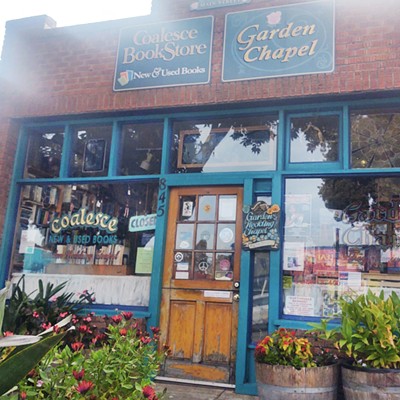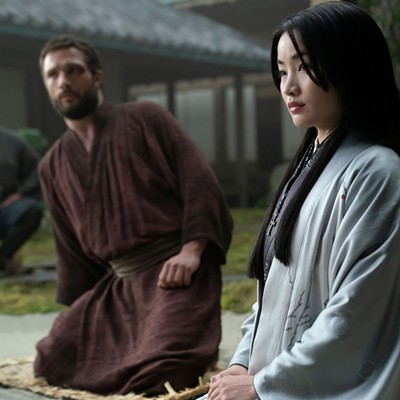Tis the season for nostalgia. While A Christmas Carol runs at PCPA, Santa Maria Civic Theatre recalls a classic that’s a century younger than Dickens’ work, but a Christmas institution in its own right: Frank Capra’s beloved film It’s a Wonderful Life. A financial disappointment on its initial release in 1946, the now-ubiquitous film gained new life as a holiday staple on television—and now, it comes to life on the SMCT stage, directed by civic theater regular Dixie Arthur.
As implied by the subtitle, “A Radio Play,” the piece, adapted by by Joe Landry, goes for a kind of nostalgic double-whammy, recalling both the classic movie and the idea of the whole family gathering around the radio to hear a story.
We are made to feel as if we’re the studio audience at a live Christmas Eve radio broadcast in 1946. The rather Art Deco look of the studio (set construction by Cliff Buck) evokes the period. There’s an “On Air” sign and an “Applause” sign. Johannes S. Beals sits in plain view at stage right (playing Gordon “Boom Boom” Wilcox), providing sound effects for the “broadcast”—slamming a door, sloshing water, tapping shoes (flats for men and high heels for ladies) on his desk, or sometimes crunching the footwear through a pan of cornflakes. Taylor Landry and Karly Willis also lend atmosphere as the station’s stage managers.
Stepping up to the microphones is a fictitious cast of radio personalities, led by Freddie Filmore (Keith Cox), who also acts as narrator. (Freddie Filmore was the name of a radio host character who appeared in a couple of episodes of I Love Lucy, played by Frank Nelson. In one episode, Lucy appeared on his game show, Females Are Fabulous, which is also referenced in this play, suggesting that this is supposed to be the same Freddie Filmore.)
The story begins on Christmas Eve in the small town of Bedford Falls, NY, where numerous citizens are praying for a man named George Bailey.
In heaven, their prayers are heard by head angel Joseph, who passes the case on to an “Angel, Second Class” named Clarence Odbody.
Joseph takes Clarence on a tour of George’s life. Over the years, George’s ambitions to leave Bedford Falls and see the world are frustrated by his loyalty to his father’s Building and Loan business, which helps the poor get decent homes. The villain of the piece is local slumlord Henry F. Potter (that’s Henry Potter, not Harry), who wants to take over the Building and Loan because it’s the only thing in Bedford Falls he can’t get his hands on using his wealth.
[image-2]
They come up to the “present” of 1946, when a lost $8,000 bank deposit puts the Building and Loan and George himself in jeopardy. Just as George is contemplating suicide, Clarence is sent in. If he can save George, he’ll “earn his wings” as an angel.
This radio play version naturally misses out on a lot of the film’s famous visuals, but it works because it allows the audience to picture those visuals in their minds without trying to replicate them onstage. (Assuming you’ve seen the film. You have, haven’t you?) Most of the actors take on multiple roles, and their voices are distinctive enough that we always know which character they’re supposed to be.
Cox’s charming Filmore also plays various roles, most prominently the menacing Mr. Potter and the lovably befuddled Uncle Billy—sometimes both in the same scene. When playing Potter, he gives the “warped, frustrated old man,” a warped, frustrated voice that sometimes gets a bit too squeaky during moments of high emotion. (Though the exaggeration could be part of the “radio play” style.)
Westley Kossuth plays the main role of George Bailey. Kossuth doesn’t try to do Jimmy Stewart’s distinctive voice—instead of an impression, he gives a sincere performance of his own.
Jack Wells (as Harry “Jazzbo” Heywood) is endearingly eccentric in the role of George’s guardian angel Clarence.
Nancy Kushinige’s Lana Sherwood is sweet and funny as both George’s mother, who encourages his reluctant romance with Mary, and Mary’s mother, who discourages it.
[image-3]
Angela Herrick plays Carmen Maxwell, who has a 1940s starlet quality. She plays both George’s eventual wife, Mary, and the local flirt, Violet Beck.
Laura Miller, as “Little Marcey Kelly,” plays George’s even littler daughter Zuzu, with an adowable lisp, as she asks her daddy to paste petals back onto a flower in one of the piece’s most iconic scenes.
While much of the movie’s well-known dialogue remains intact, some scenes are trimmed or left out entirely, presumably because they didn’t fit the format. The play also adds in an unnecessary scene in which Potter bribes a bank inspector. The only point to it seems to be establishing that Potter took the $8,000 on purpose (which was accomplished in the movie simply by showing the expression on his face).
The play has some fun with the radio concept, including a hilariously cheesy period commercial (complete with a jingle set to a Christmas carol tune) that closes out Act One. At the end of Act Two, there’s another commercial that’s similar in tone, but it comes off as jarring, launching immediately after a dramatic scene in which the distraught George berates his family. On the other hand, it’s probably true to the radio show experience, as real commercials don’t typically match the tone of the show they interrupt.
This version won’t replace the movie in your mind, but it does act as a charming companion piece, and a heartwarmingly nostalgic way to celebrate the holiday season.
Atta boy, freelancer Brent Parker! Contact him via Arts Editor Shelly Cone at [email protected].









